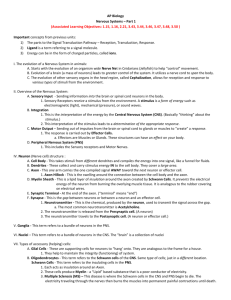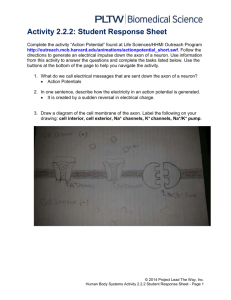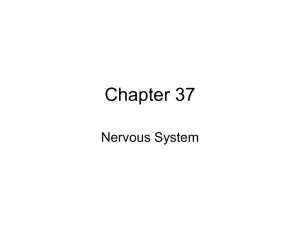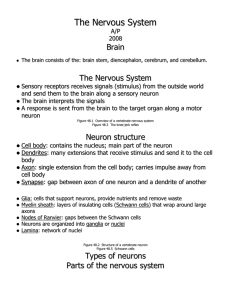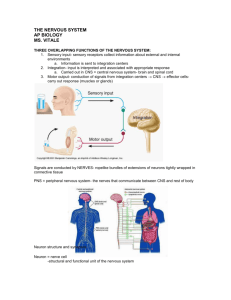Lecture-Apr 17 TYPE
advertisement
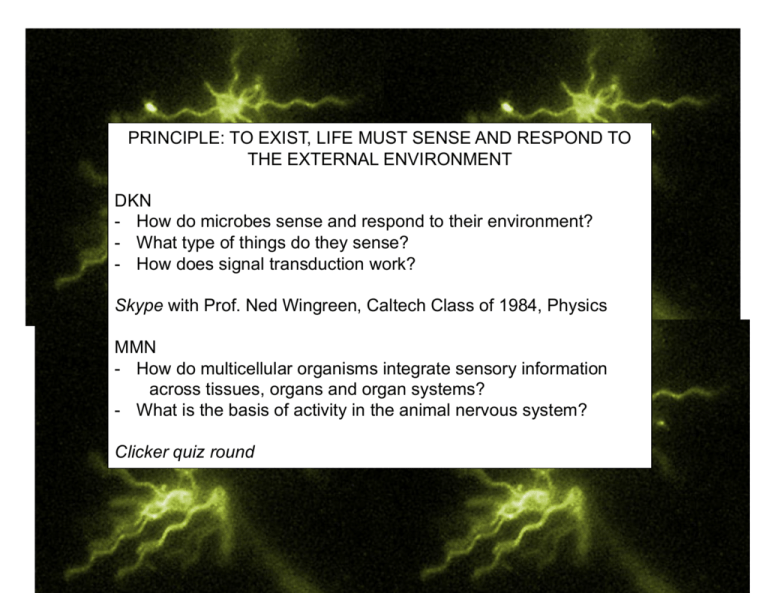
PRINCIPLE: TO EXIST, LIFE MUST SENSE AND RESPOND TO THE EXTERNAL ENVIRONMENT DKN - How do microbes sense and respond to their environment? - What type of things do they sense? - How does signal transduction work? Skype with Prof. Ned Wingreen, Caltech Class of 1984, Physics MMN - How do multicellular organisms integrate sensory information across tissues, organs and organ systems? - What is the basis of activity in the animal nervous system? Clicker quiz round Marvel's Fantastic Four comic #72 How do microbes sense their environment? Overview cartoon: sense (input) integrate respond (output) If you were a microbe, what information form the outside would you care about? - Nutrients (attractants, e.g. light, organics, inorganics -can be both substrates & products) - Toxins (repellents) - Stress (e.g. cell envelope stress) - Time (circadian rhythms) - Other cells (relatives) - Other cells (competitors) How do microbes sense, integrate and respond to external cues? Answer: 2-component systems input Sensor histadine kinase (HK) membrane dimer out in histidine membrane 25% have a phosphorelay w/ other proteins… aspartate Response regulator (RR) There are many different types of inputs, integration & outputs. output Highly modular! Domain architecture of sensor histidine kinases (HK) (INPUT domain): Dimerization/phosphotranser, catalytic DHp CA tm tm tm tm DHp CA tm tm DHp CA tm tm DHp CA CA = ATP binding, catalyzes autophosphotransfer to DhP domain, Which then transfers It to RR Extracellular signal Transduce signal Examples of how a domain senses light: LOV (light-oxygen-voltage) domain, belong to PAS superfamily (Per-Arnt-Sim) Non covalently bound flavin cofactor, makes a covalent bond when absorbs blue light, results in conformational rearrangement of the protein: LOV domain of C. reinhardtii Domain architecture of response regulators (RR) (OUTPUT domain): Receiver domain Effector domain D DBD D AAA+ D GGDEF D EAL DNA-binding 60% DBD Cyclic-di-GMP methyltransferase D D CH4 CheY, chemotaxis example 15% Caltech iGEM 2011 Team – Designed bacteria to degrade endocrine-disruptors (compounds that disrupt development & reproduction of wild organisms) A Sampling of Two-Component Signal Transduction Systems His+dine Kinases Response Regulators Total Caulobacter crescentus 62 44 106 Sinorhizobium melilo7 36 50 86 Bacillus sub7lis 21 31 52 Escherichia coli 29 32 61 Geobacter sulfurreducens 86 75 161 Nostoc punc7forme 120 131 251 Streptomyces coelicolor 84 80 181 Pseudomonas aeruginosa 60 73 133 Streptococcus pneumoniae 7 12 19 Staphylococcus aureus 9 13 22 Saccharomyces cerevisiae 1 2 3 Dictyostelium discoideum 13 2 23 Arabidopsis thaliana 8 23 31 Figure from M. Laub, MIT Organism 1.) A lot in bacteria but absent in metazoans: antibiotic target! 2.) What challenge might this abundance of 2-component systems pose? FimZ CpxR PhoP BasS OmpR PhoQ CpxA PhoB EnvZ PhoR CusS CusR BasR CheY Specificity? SprE YfJR YNK YedW YedV QseB QseC BaeR BaeS HydG HydD UvrY BarA diagram by Mark Goulian Solving the problem of specificity…. Control over production of the sensor (regulation) Control over spatial localization of the sensor/response regulator Fine-tuned molecular specificity***, achieved by co-evolution Specificity determining residues identified by coevolution analysis HK-TM0853 HK RR 12 18 19 22 23 RR-TM0468 13 16 19 20 25 26 Figure from M. Laub, MIT 104 structure: PDB 3DGE Two examples of signal transduction: A.) Chemotaxis input attractant output tumbling frequency B.) Quorum Sensing (bacteria can count!) input counts cell # output makes light (other things) Chemotaxis: Biased random walk CW rotation: tumble; CCW rotation: run http://emonet.biology.yale.edu/agentcell/ Movie of chemotaxis – run and tumble Howard Berg (Caltech class of 1956, Chemistry) Professor of Physics, Harvard How do cells adapt to new conditions yet preserve their ability to respond? Concept of robust exact adaptation – lecture reading assignment! Sketch out Figure 7.5, 7.10 from reading! Moral of the story: ability to return to the steady state activity does not depend on ligand levels (robustness) But the ligand levels fine tune the exact steady state level (data in Fig. 7.11) Extra credit question (worth one iClicker question): under what conditions does robustness break down? Solve mathematically, using specific components of the chemotaxis network. Due in class next Tuesday at beginning of lecture. Quorom sensing: sensing oneself (mechanism for “social behavior”) K. Nealson and W. Hastings discovered in 1970 (Nealson Thursday!) Auto-induction, critical threshold Signal Receptor Protein This is another two component system Signal Producing Protein Gene transcription (results in making light) Dramatic examples of quorum sensing… Hawaiian bobtail squid Euprymna scolopes Ruby and Mcfall-Ngai Vibrio fisherii, bioluminescence Egland and Leadbetter …responsible for the “milky seas” described by ancient mariners (Vibrio harveyi associated with microalgae) Jan. 25, 1995 ~ size of Connecticut PNAS (2005) 102:14181-14184 Quorom sensing: sensing oneself AND OTHERS! Rich chemical lexicon! Intra-species Intra-genus Signal Producing Protein virulence, biofilm formation, etc... Inter-species http://www.ted.com/talks/bonnie_bassler_on_how_bacteria_communicate.html Movie of traveling waves in Myxobacteria Dale Kaiser (Ph.D. Caltech, 1955) Professor of Developmental Biology, Stanford = Accessible application of blocking QS: prevent refrigerator rot! How could you do this? Erwinia carotovora Application of blocking QS: prevent rotten lettuce in your refrigerator! How could you do this? Erwinia carotovora PRINCIPLE: TO EXIST, LIFE MUST SENSE AND RESPOND TO THE EXTERNAL ENVIRONMENT DKN - How do microbes sense and respond to their environment? Using highly modular 2-component systems - What type of things do they sense? Attractants, repellents, cell number, time, stress… - How does signal transduction work? Sensor histadine kinas detects signal, phosphorelay activates response regulator PRINCIPLE: TO EXIST, LIFE MUST SENSE AND RESPOND TO THE EXTERNAL ENVIRONMENT DKN - How do microbes sense and respond to their environment? - What type of things do they sense? - How does signal transduction work? Skype with Prof. Ned Wingreen, Caltech Class of 1984, Physics MMN - How do multicellular organisms integrate sensory information across tissues, organs and organ systems? - What is the basis of activity in the animal nervous system? Clicker quiz round Sensing/integrating/responding to the environment Unicellular – receptor on the cell/ integration across the cell/ effector mediates response Multicellular – 2 interacting tasks: 1) responding to the abiotic environment 2) coordinating cells Nature of the: - Sensors - Integrators - Effectors A. Animals - nervous and endocrine systems in animals – typical short vs. sustained B. Plant hormones response environmental cue phosphorelay effector P sensor integration of transcriptional regulation environmental cue (e.g., shed bacterial surface molecules) NF-kappaB pathway phosphorelay P integration of transcriptional regulation Sensor transcription factor effectors David Baltimore response (e.g., cell death) environmental cue response sensor transmitters integrators effector Coordination of a multicellular organism cells – tissues – organs – organ systems FASTER RESPONSE nerve cell - e.g., myelin – e.g. brain - nervous system plant growth SLOWER, SUSTAINED RESPONSE progression of insect development secretory cell - e.g., islet cells – pancreas – endocrine system (make insulin) Trends in Nervous System Evolution and Correlations with Body Plan No well coordinated NS, no symmetry nerve net eyespot brain nerve cords Transverse nerve Increasing cephalization ~300 million neurons in brain Bidirectional nervous conduction Radial symmetry Unidirectional nervous conduction Bilateral symmetry ~100 billion neurons in brain Spinal cord 1 billion environmental cue sensor response transmitters integrators effector ANIMAL NERVOUS SYSTEMS receptor afferent BRAIN OR SPINAL CORD FROM : Simple reflex arc effector relay efferent Example of a reflex arc Z-fish movie Complexity of wiring for complex human behavior: Human brain ~100 billion neurons – 10,000 neuronal classes each nerve cell or neuron communicates with 1000 others. HAR1 To: More complex behaviors Neural circuitry and the genetics of aggression David Anderson Div Biology, Caltech Movie M Konishi Caltech E Knudsen Stanford U Multiple exposure (infrared) of owl hunting in the dark Locates prey by using time over which sound reaches the two ears, which are assymmetric Interaural time difference Time lag! Time lag! Sound-source localization Complex neural computation that translate auditory location cues into representations in space. The system is integrated with the owls visual system; learned. Owl chicks – with prisms. Orienting responses to auditory or visual targets Before Prisms auditory visual Day 1 (R23º Prisms)! +10 L10 +10 R 10 20 30 L10 -1 0 -1 0 Eight weeks! Prisms Removed! +10 +10 R 10 L10 -1 0 30 L10 R 10 -1 0 30 Prism experience shifts auditory receptive fields Normal L20 0 Immediate Effect of Prisms After 8 Weeks of Prism Experience R20 +20 0 –20 A! A! V V A! V V What are these cells and how do they function? Nerve cell = neuron 3 principal kinds: receptor afferent BRAIN OR SPINAL CORD Sensory neuron Interneuron (relay) Motor neuron effector efferent Structure of a neuron Direction of neural transmission stimulus Dendrite (receiving) Axon (sending) uninsulated node nucleus Synapse (electrical or chemical) insulation (myelin) +/- Speed: nervous conduction – myelinated (vertebrate nerves, with an exception) – up to 100 m/sec unmyelinated (invertebrate) – typical up to 1 m/sec giant axon (1 mm diameter max) aver 0.5 mm - 25 m/sec Physiology of a neuron – selection on a pre-existing character of all cells – membrane potential - difference in charge across the membrane K+ 5 mM Na+ 150 mM Cl- 120 mM K+ 150 mM Na+ 15 mM Cl- 10 mM Amount of membrane voltage at equilibrium = equilibrium potential (Eion) is given by Nernst equation, applies to single ion type. log [ion] outside Eion = 62 mV log [ion] inside Thus, for K+ log 5 mM Ek = 62 mV log 150 = - 92 mV (at body temp) Na+ + 62 mV Membrane potential always described as inside relative to outside Typical membrane potentials: bacterial cell = -140 to -105 mV mammalian neuron = - 60-70 mV MEMBRANE POTENTIAL ACTUALLY SET BY K+, as more K+ channels open at rest MAINTAINED BY PUMPS IN THE MEMBRANE Action potential a depolarization of the membrane - nerve fires Direction of neural transmission stimulus Dendrite (receiving) Axon (sending) uninsulated node SUM OF EXCITATORY & INHIBITORY INPUT nucleus Synapse (electrical or chemical) insulation (myelin) +/ACTION POTENTIAL BEGINS HERE Action potential - a depolarization of the membrane Action potential - a depolarization of the membrane 3 out 4 in Na+ K+ Na+ K+ 1 K+ Na+ K+ Na+ Na+ Na+ channels open 6 2 Na+ 5 K+ Na+ K+ Na+ K+ Na+ K+ X out Na+ X in Na+ K+ Na+ channels close/K+ channels open Na+ K+ Potassium channels close K+ K+ Direction of neural transmission dendrite axon terminal cell body axon nucleus Axon terminal of motor neuron interfaces with effectors: e.g., muscles chromatophores node receptor afferent Sensory neuron Motor neuron effector Interneuron (relay) efferent


